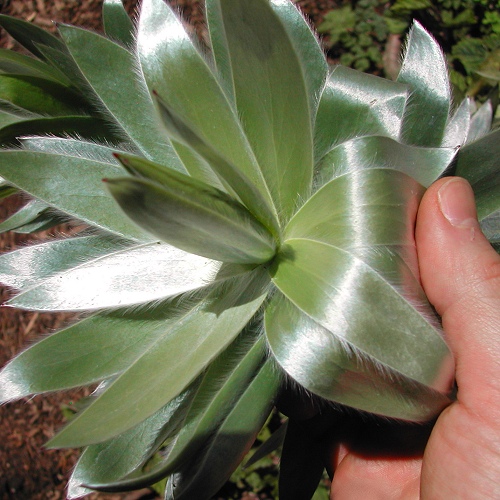Germinating the seeds
When to plant -- Plant your seeds promptly when you receive them.. Soil -- Use a well-draining soil mix that is slightly acid. A typical mix is 2 parts quality potting soil to 1 part perlite (small- or medium-size - avoid large chunks). Don't add lime to the mix. An alternate mix is 3 parts perlite to 2 parts coco fiber or peat moss, and mix in granular fertilizer that contains micronutrients, at 1/2 the dosage recommended on the package. Choose a low-phosphorus fertilizer - more on that below. Pots - Each seed should go in its own pot (or cup with drainage holes). The seedlings should not be transplanted for a few months. Use containers at least 5 inches tall (13 cm). Fill the pots with the soil mix, place a seed on top, and cover so the top is about 1/4 inch (7 mm) below the surface. It's best to avoid tap water with a high pH (alkaline or "hard" water). When in doubt, use bottled water or rain water. Water the pots until the soil is evenly moist, but not fully saturated. Keep it this moist until they sprout. Place the pots in an area with some air circulation. Don't enclose them a humidity dome, which can encourage mold. Temperature -- I recommend placing a minimum/maximum thermometer near the pots. During the day, try to keep them between 50 and 78° F (13-26°C). Avoid letting them get too warm. Cool nights help germination. At night, try to keep them below 62°F (17°C) but above freezing, perhaps on the floor of a cool room. Once they sprout, you can move them to a warmer spot (below 80°F / 26°C). If you don't have a cool spot to germinate them, you can try putting the pots in the refrigerator for 6 weeks (put them in a sealed container or bag first). They sprout at different times, usually between about 6 weeks and 3 months, but a few may take longer. Lighting the seedlings -- Give them bright light, away from strong sun the first 3 months. While they are small, you may use an LED panel or bright fluorescent lamp kept 2-3 inches (5-8 cm) away (See: "Growing indoors with LED lights"). Watering: Once they are 2 inches (4 cm) tall, you may allow the surface soil to dry out, but aim to keep the rest evenly moist most of the time. After 4 inches (8 cm) tall, you can allow it to dry out about halfway between waterings. Don't let it dry out completely. Fertilizer -- The Silver Tree prefers low fertilizer levels, especially low phosphorus (the "P" in "N-P-K" on the label). The fertilizer should have more N (nitrogen) than P, and contain micronutrients. If your potting mix contains fertilizer, like most do, the plants shouldn't need feeding the first 3 months. After that, feed at 1/2 strength about every 3-4 months. Growing onward... Climate -- Established plants prefer temperatures between 40 and 85°F (5-29°C), with cool nights (below 65°F / 18°C). They can only take a light frost, so it's best to protect them from all frost. They might not like very dry air. Lighting -- Once they are about 6 inches (15 cm) tall they should be able to take a few hours of sun, but gradually adapt them to this over a few weeks. Watch for burning or wilting as you increase the light. After about 12 inches (30cm) tall, if the leaves are not closely spaced, the lighting may be too weak. Repotting -- Once they are about 4 inches tall (10 cm), you may repot them to larger containers about 1 pint (1/2 liter) to 1 quart (1 liter) in size. Silver Tree doesn't like having its roots disturbed, so avoid letting the soil ball break apart (water it first to keep it together). Reduce exposure to strong sun the first 1-2 weeks after repotting. After about 8 months, you can plant it in the ground in suitable climates. If you keep it in a pot, use a larger size than usual for a plant its size, to keep the roots cooler. In warmer climates, shade the pot, perhaps by placing it inside a second pot made of clay. Root rot -- The plant is susceptible to Phytophthora root rot, especially if overwatered in warmer conditions, or if the roots are damaged. Infected plants can die very rapidly. As a preventative, you can try using a biofungicide like "Garden Friendly Fungicide" by Southern Ag. Contact me if you have questions about fungicides. Pruning -- Once they get over 12 inches tall, you may prune the tip if you require shorter plants indoors. Outdoors, pruning isn't necessary. General info on the plant is here. If you have any questions or problems, feel free to contact me. Have fun growing them! - Jeff Strange Wonderful Things
|
|||||||||


